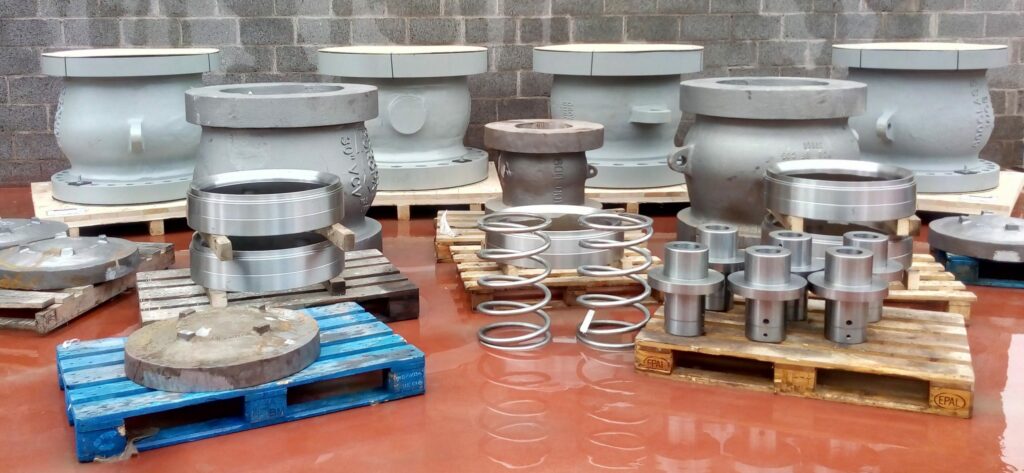Check valves are different from other types of valves in their ability to pass fluid in solely one direction. They have two ports, one as an inlet for the media and one as the output for the media. Since they only allow media flow in one direction, they are commonly referred to as one-way valves or non-return valves. This sort of function is essential for a variety of safety applications as well as for preventing overflow. So in this blog, Linquip will discuss the check valve function and working principle. Read on to find out more about this type of valve.
What is a check valve?
As mentioned above, a check valve, also called a non-return valve, reflux valve, or one-way valve is a valve that normally allows fluid (liquid or gas) to flow through it in one direction only. It is a mechanical device used in piping and pipeline systems to prevent back-flow. Chemicals, pulp and paper, food processing, water and wastewater treatment, industrial, marine and mining, pumps, pipelines, power generation, and HVAC are among the many fluid flows and pumping applications that feature check valves.
With a huge range of potential applications, there are also multiple types of check valves that use many different materials such as metal, polymers, and rubber. Common designs include swing or flap check valves in which a metal disc pivots on a hinge or trunnion to prevent reverse flow. Larger check valves are typically of the swing or flap type. As the name suggests, ball and spring ball check valves feature a ball that mounts in an appropriately profiled seat. Duckbill check valves rely on a flexible rubber diaphragm which creates a valve that is normally closed unless positive pressure is applied.
Check Valve Working Principle
As already stated that a check valve operates on the principle of differential pressure. For a check valve to open, it must attain a minimum upstream pressure known as cracking pressure. Depending on the check valve design and size, the cracking pressure changes. When the upstream pressure reaches the cracking pressure, the valve opens allowing the fluid to enter. When the upstream pressure falls below the cracking pressure, back pressure is generated and the flow attempt to move from outlet to inlet. At this point, the check valve closes, and the flow halts. The closing mechanism of a check valve varies depending on the design and type of the valve. Spring or Gravity pressure normally assist the closing process.
As one-way valves only work in one direction, it is crucial to know the correct installation orientation. Oftentimes, there is an arrow on the valve housing to signal the flow direction. Otherwise, you will need to examine the valve to ensure it is installed in the intended flow direction. If it is backward, the flow will not be able to move through the system and a build-up of pressure could cause damage.
Read More on Linquip
- The Essential Guide ToSolenoid Valves Working Principle
- Facts About TheFlow Control Valve Function
- Check Valve vs Backflow Preventer
- Parts of Check Valve
- Top Check Valve Manufacturers in the USA
Check Valve Function
The key functions of check valves are to prevent the medium from flowing back, to prevent the pump and its generator from reversing, and to prevent the medium from flowing back from the container.
Furthermore, the check valve is used to substitute the auxiliary system at which pressure can increase above the pressure of the main system. If the flow reverse and no check valve is fitted, water hammer can take place. Water hammer often occurs with excessive force. This phenomenon can see repeated extreme pressure surges in connected pipework, valves, and pumps that may fatally damage or rupture the system and its pipework. Even if a failure does not occur immediately, the repeated impact of the water hammer can promote fatigue that may also ultimately result in a loss of system integrity.
Check valves are also a major component in hydraulic processes which saves your system against a very costly shutdown. They are used for flow, directional, and pressure control. They are critical in preventing pressure build-ups and fluid restrictions, which can lead to system failures.
Besides, frequently check valves are placed in series, for instance in water systems to prevent backflow of contaminated water into clean water supply lines.

So, this was everything you needed to know about the check valve function. If you enjoy this article, let us know what you think by leaving a reply in the comment section. We will be more than glad to have your viewpoint on the article. Is there any question we can help you through? Feel free to sign up on Linquip where our experts are prepared to provide you with the most professional advice.
Read More on Linquip
- Check Valve Manufacturers
- Solenoid Valve Manufacturers
- Needle Valve Manufacturers
- Plug Valve Manufacturers
- Ball Valve Manufacturers
Buy Equipment or Ask for a Service
By using Linquip RFQ Service, you can expect to receive quotations from various suppliers across multiple industries and regions.
Click Here to Request a Quotation From Suppliers and Service Providers






I so much appreciate your effort on this site, its very educative and simplified. Thanks.
VICTOR, we appreciate you stopping by our site and expressing your thoughts. In future articles, we welcome your feedback and comments. You can also visit our industrial directories, where you can find thousands of various industrial equipment based on your application and demand.